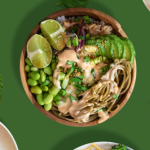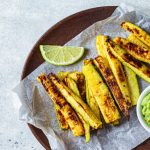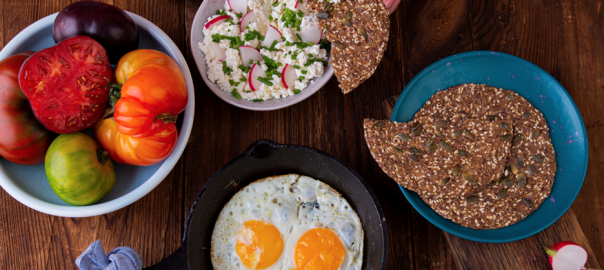
Low Carb Snacks – Clean Eating
Kick Cravings with Clean Eating
Learn what your cravings really mean and how you can satisfy them quickly and easily with these versatile low carb snacks from Clean Eating!
It was mid-morning; I had an early start to a busy day and didn’t get a chance to finish my morning coffee. I’m not going to lie, the only thing on my mind was a dark chocolate sea salt cookie from my favourite bakery in town. They are buttery and dense, and probably a little too sweet. But how was I going to get one of those? No time to go grab one and, quite frankly, I didn’t want to load up on sugar because I knew I would crash later – busy day ahead.
So, I quickly threw together a grazing board with a bunch of low carb, low sugar ingredients to help satisfy my craving. I crumbled a Clean Eating organic crispbread into bite-sized pieces, added some slices of sharp, salty Parmesan cheese, a few chunks of dark chocolate, and a handful of raw almonds. Hear me out – this might sound like an odd combination, but it truly hit the spot and made my cookie cravings disappear!
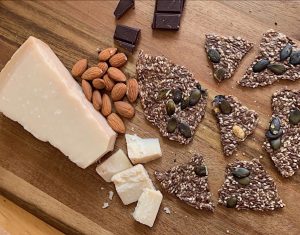
The fat and protein from the cheese and the almonds fended off my hunger, while the chocolate, although it was sugar-free, gave me just the boost of energy (and dopamine) that I needed! The crunchy crispbread was the perfect vessel to tie it all together – a slice of cheese on top of a piece of crispbread a salty, crunchy, and satisfying bite! Follow that up with a piece of chocolate and a few almonds and I had just the right balance of sweetness and healthy fats!
Since these crispbreads are made with flax seeds, psyllium husk fibre and wheat bran (select varieties are also gluten-free), they are high in soluble fibre. This means that they will absorb water from your digestive tract, creating more bulk. This not only keeps you feeling full after having just one (150 calories, 11g of fat, 2g net carbs and 6g of protein), but it also helps keep things moving along inside, if you catch our drift. This crispbread kept me feeling light for the rest of the afternoon, giving me even more energy to take on the rest of my day! And, it still felt like a little indulgence thanks to the yummy no-sugar-added chocolate and the Parmesan cheese (check out more low carb cheese options!).
Disclaimer: The information in this article is not intended to replace personalized medical advice. A low carb diet may not be suitable for you. Consult your health care provider before making any changes to your lifestyle or use this information at your own risk.
Cravings Stop Here
Our cravings don’t have to be debilitating. We can, in fact, overcome our desires for foods that not only “aren’t allowed on our diets”, but that keep us from feeling our best.
There was no way I would have felt as satisfied, energized, and ready to take on the day after scarfing down a big, sugar-y cookie. I likely would have wanted to lie down and take a nap!
When we know the right foods to feed our bodies and our brains with – despite the confusing messages they might be sending us (“eat that cookie!”) – we can actually set ourselves up for success. If you’re curious about how to master your cravings, keep reading!
What Your Cravings Really Mean
I recently stumbled upon a food cravings article talking about what these cravings might be telling us about our nutritional needs. Those pesky cravings can actually be helpful indicators for which micronutrients, such as certain vitamins and minerals, that our body may be lacking.
Homeostasis and the Critical Role of Vitamins & Minerals
Vitamins and minerals supply small but important amounts of nutrients that our bodies need to function on a daily basis, aside from macronutrients (carbs, fats, and protein) which are needed in larger amounts. They are critical components in biochemical reactions that our bodies need to carry out each day to keep us alive. This includes keeping our nerves and organs functioning properly, activating our immune systems when we are exposed to environmental stressors, producing digestive enzymes and hormones to regulate our sleep and waking cycles, building and repairing damaged cells, and removing cellular waste. All in all, this helps maintain a state known as “homeostasis” – a perfect equilibrium in which the body is able to self-adjust to maintain the conditions necessary for survival. Chronic diseases and acute conditions arise when the body is out of homeostasis.[*]
Diabetes is one common result of homeostatic imbalance, specifically from the improper functioning of insulin control mechanisms in the body. We know that many of our readers are managing type 2 diabetes, and we also know that one BIG caveat to low carb diets is sugar cravings! So, we put together this guide for your reference to help manage those cravings, stick to your diet, and beat the vicious cycle of wanting, having, and regretting.
Learning The Cravings Code
Cravings are like “codes” for our bodies’ nutritional deficiencies. When we crave sweets, we are likely dehydrated, in need of more energy, or we could be deficient in magnesium, an important electrolyte involved in more than 300 biochemical reactions. When we crave salty food, we are probably deficient in sodium or chloride – both important to have in the right balance.
These two cravings, in particular – sweet and salty – are some of the most common cravings experienced by low carb dieters. When we cut carbs from our diet, our body needs time to adjust to its new fuel source – fats – and in the meantime, it will continue “looking” for sugar, causing cravings. Try upping your intake of magnesium-rich foods such as pumpkin seeds, almonds, leafy greens, tofu and salmon, and make sure you are getting enough calories from fat and protein.
On the other hand, a number of physiological changes associated with ketosis can cause our bodies to lose water when we start a low carb diet, accompanied by our stores of electrolytes (magnesium, sodium, chloride, and calcium). This can lead to deficiencies in these essential minerals if we are not upping our intake accordingly. We may also crave salty foods since these are (very) high in sodium chloride. Instead of reaching for a bag of chips, try adding a pinch of sea salt and a squeeze of lemon juice to your water glass a few times a day to replenish these nutrients. Olives, seaweed, romaine lettuce, tomatoes and celery are also great low-carb choices for satisfying salty cravings.
To learn more about the importance of salt on a ketogenic diet, head over to our blog. In the meantime, here are some more common cravings and what they mean:
- Soda & Carbonated Drinks = Calcium
Cravings for soda, or carbonation in general, may indicate a calcium deficiency. This is because carbonated drinks actually have the effect of removing calcium from our bones in order to feed the body’s needs. Instead of poaching your body’s own resources, supplement with more calcium in your diet!
Dairy is the main food source recommended to help us increase our calcium levels. While it certainly does contain high levels of calcium and is a good low carb option since it is naturally low in sugar and high in fat, there are other foods out there too that are rich in calcium! Many plants contain high levels of calcium. Think about it; what gives those cows so much calcium in their milk? Their plant-based diets!
Plants grown in calcium-rich soil absorb this and other essential minerals through their roots, where they are then transported to the plant’s cell walls and cell membranes – which we consume (raw for highest nutrient absorption or cooked for easier digestion).
One of the best ways to get more calcium – even from your dairy products – is to choose grass-fed products over traditional grain-fed varieties. Try grass-fed milk, yogurt, sour cream and cheeses. Goat and sheep’s dairy are also great choices for those who are less tolerant to cow’s milk since the proteins in these animals’ milk is easier to digest. Learn more about grass vs. grain fed dairy and meat on our blog!
Other delicious plant-based sources of calcium include:
- Kale – try massaging your kale with olive oil, salt and pepper for better texture and add a squeeze of lemon juice for greater nutrient absorption!
- Mustard greens – sauté these with garlic and olive oil or include them in your salads!
- Broccoli, cabbage and okra – add these to soups, stews, casseroles.
- Almonds – great for a quick snack; just grab a handful!
- Chia seeds – make delicious chia seed pudding, add them to your low carb cereals and granolas, or try keto-friendly chia seed jam!
- Sesame seeds – deliciously abundant in Clean Eating Crispbreads! (Also in tahini and halva).
- Soya beans (tofu, tempeh, unsweetened soy milk, or soybean noodles)
- Canned sardines and salmon – particularly high in calcium since the edible bones are loaded with calcium!
Here’s another topping combination to try with Clean Eating low carb crispbreads: tahini, sundried tomatoes (high in electrolytes and essential minerals), cayenne pepper for a little extra spice benefits, and fresh basil leaves! This would taste delicious on Tomato Onion (vegan, gluten-free), Parmesan (gluten-free), or new Chive & Protein Powder flavoured crispbreads!
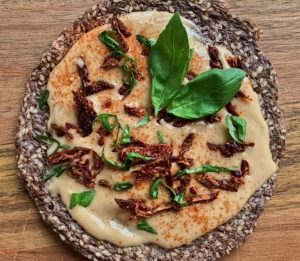
- Fried foods = Essential Fatty Acids (ALA, DHA & EPA)
Cravings for fried foods may suggest a lack of essential fatty acids. The word “essential” in essential fatty acids indicates that these lipids cannot be synthesized by our bodies, or not in adequate amounts, so we must obtain them from our diets.
The three types of essential fatty acids have long, confusing names – so we’ll just call them ALA, DHA and EPA for short. ALA fatty acids are found in plants, such as flax seeds and flax seed oil, pumpkin seeds, soya beans and tofu, and walnuts. DHA and EPA (main sources include fatty fish, grass-fed meat, and certain marine algae) are often deemed the more important of the three essential fatty acids since they play critical roles in brain development and cognitive function. However, all three are involved in providing energy sources for all of the complex, interconnected systems in our bodies.
Fried foods are usually made with oils that aren’t the best natural sources of essential fatty acids, such as refined canola, soybean, or peanut oil. These oils are also typically modified so that they last longer in the fryer at high temperatures, requiring less frequent oil changes that can slow down fast food service. These modifications result in higher trans fat and carcinogen levels and refine away many of the original nutrients.
Instead of greasy fried foods, here are some delicious ways you can enjoy clean fat sources to get your required doses of ALA, DHA and EPA!
- Salmon, mackerel, sardines and anchovies (or any other low-mercury, fatty fish) – enjoy on top of salads, low carb pizzas, or on a piece of toasted low carb bread 2-3 times a week.
- Ground flax seeds sprinkled over meals or added to smoothies!
- Walnuts added to salads, soups, or crushed over some low carb vegan mac and cheese – yum!
- Avocados served alongside pretty much anything!
- Extra virgin olive oil drizzled over pretty much everything, too.
- Unrefined/virgin coconut oil – perfect for at-home frying to replace those fried foods, thanks to its high smoke point.
- Pasta, bread, and pastries (carbs) = Chromium
Chromium is related to the body’s insulin response, the key hormone involved in the metabolism of carbohydrates. Chromium improves the body’s response to insulin, so a deficiency in this mineral can cause cravings for carbohydrates since insulin won’t be able to function properly.
When we become insulin resistant, our muscles don’t allow glucose to enter their cells to be stored as energy for later. As a result, the excess glucose enters the blood stream and gets transported to fat cells instead, causing weight gain and cravings for carbs as our muscles send messages to our brain asking for more quick energy. Improper insulin function also affects our blood sugar levels and can throw our hunger hormones out of balance, too. All of this contributes to further homeostatic imbalance – and a mean hankering for a donut!
Instead of giving into these cravings – pause. Understand what these feelings really mean; you’re just in need of a little nutrient boost! Choose chromium-rich foods to fuel up with such as:
- Onions
- Romaine lettuce
- Swiss chard
- Tomatoes
- Bell peppers
- Celery
- Avocado
Sounds like a salad to us! Check out our low carb and low calorie salad dressing options to take things up a notch.
Cinnamon has also been shown to promote stable blood sugar levels and elevate the effects of chromium.[*] Pairing cinnamon with chromium-rich foods can give you a one-two punch of health benefits. While cinnamon may not exactly “go” with some of the vegetables mentioned above… consider adding it to spice blends to make delicious curries, chilli, or soup! Milk and dairy products also contain some chromium, so you can try sprinkling cinnamon over a bowl of yogurt, for example. And, if your diet allows, enjoy chromium-rich whole grains, sweet potatoes, and fruits such as apples with cinnamon! A bowl of Goldy’s Superseed Cereal topped off with a little brown sugar substitute and cinnamon is the perfect low glycemic breakfast. You can also snack on apple slices coated in cinnamon and dipped in almond butter.
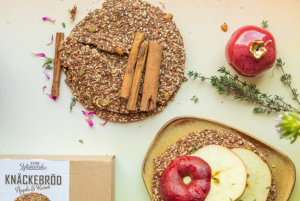
Or, reach for an Apple Cinnamon Clean Eating Crispbread and top that with some nut or seed butter for a low carb high fat option! Brazil nuts are especially high in chromium, so if you can find Brazil nut butter at your local supermarket, or make your own by blending soaked Brazil nuts in a high power blender, that’s a great choice. Did you know Clean Eating Chunky Breakfast Cereal contains both Brazil nuts and cinnamon? Try this delicious keto-friendly cereal with milk or over yogurt for the ultimate chromium-filled breakfast!
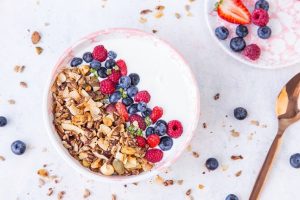
Discover more recipes and ways to enjoy Clean Eating low carb snacks by following us, @lowcarbgrocery!

Stay Connected
We hope that you learned something new about your cravings and enjoyed reading this article. If you would like to share your experiences or thoughts on this topic with our low carb community, head over to our Facebook page and leave us a comment under this article!
On your way out, don’t forget to leave us your feedback with a Google Review and remember to sign up for our weekly email newsletter to stay on track of our sales, news, and blogs!





